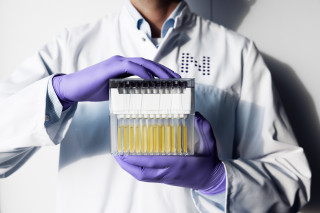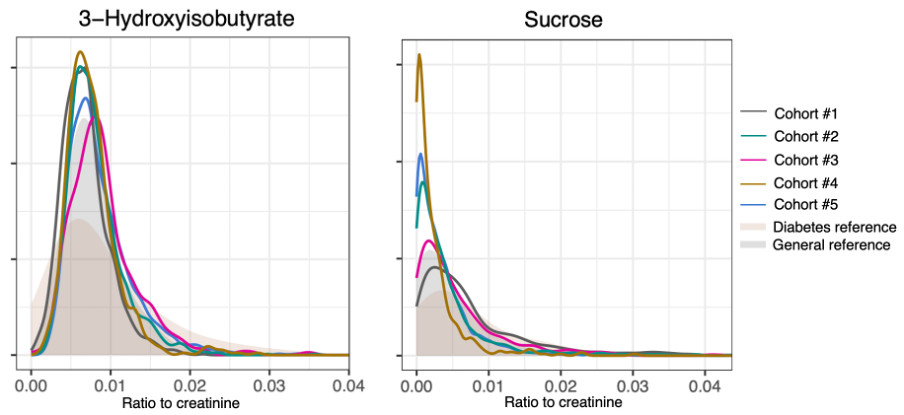Urine Metabolite Profiling: From Studies of Diabetes Patients to General Population Cohorts
Solution spotlight May 08, 2025

Most urine biomarker studies focus on improving our understanding of kidney function. Indeed, biomarkers such as urinary albumin are essential in studies of patients with diabetes and kidney disease but are not commonly measured in general population cohorts. Technological advancements in urine metabolomics now make it possible to profile entire cohorts and biobanks, as in the case of plasma. Urine metabolomics offers molecular links between exposures and disease risk, for example as readouts of diet and gut microbiome. Here we highlight recent studies demonstrating the relevance of urine metabolites beyond markers of kidney function. We also illustrate the consistency of urine metabolites across cohorts, which provides strong optimism for robust biomarker discoveries in relation to health and disease.
Metabolite profiling of blood samples by nuclear magnetic resonance (NMR) has grown into a mature research tool used routinely in hundreds of cohorts from all over the world. The results arising from UK Biobank and other biobanks also underpin implementations in clinical settings. Yet, when the first NMR metabolomic studies using blood samples emerged, the point of measuring amino acids and many other metabolites was questioned because their clinical relevance was unclear. Nowadays, these metabolites are established as markers of insulin sensitivity and can improve the prediction of aging processes. In the same way, many urine metabolites that now seem like molecular curiosities may turn out to be important biomarkers with relevance widely beyond kidney function.
The physiological roles of urine metabolites remain mostly unknown, but new studies start to map these blank spots. A recent paper from the FinnDiane Study of individuals with type 1 diabetes reported multiple urine metabolites associated with risk of heart disease onset.¹ An abstract from the ARIC study, a general population cohort, reports many of the same urine metabolites to be associated with mortality risk.² This illustrates that many urine biomarker findings are not unique to people living with diabetes. Another recent paper identified novel genetic mechanisms regulating urine metabolite concentrations. By combining the results from genome-wide association studies in the FinnDiane Study with those from two Scottish general population cohorts, the researchers identified 33 novel genetic variants regulating metabolites in urine.³ The gene-metabolite associations were consistent in the three cohorts despite different patient characteristics and urine collection protocols.
NMR metabolomics enables easy urine biomarker replication
Combining results from multiple cohorts is key to robust discoveries of novel biomarkers. Nightingale Health has delivered NMR-based urine profiling for a few years, and a number of cohorts now have urine metabolomics data available. This makes it easy for new cohorts to find opportunities for replicating their findings. Our experience working with urine metabolomics data across multiple cohorts worldwide also starts to provide a firm understanding of the consistency of metabolite levels in urine. The overall picture emerging is one of remarkable consistency in the metabolite distributions regardless of where in the world and what time of the day the urine is collected. The Figure below illustrates this important point for two metabolites, showing how the distributions are almost fully overlapping in five individual cohorts. The metabolite distributions in each cohort also match the overall reference distributions that are compiled from more than a dozen of cohorts. These reference distributions are provided to newly profiled cohorts to set their own results into perspective. The reference distributions are divided into ‘general population’ and ‘people with diabetes’ because a substantial fraction of metabolites differ based on diabetes status—not only for glucose but also for metabolites in several other metabolic pathways.

Figure: Illustration of the consistency of urine metabolite distributions across five cohorts.
Two metabolites are shown to serve as examples. Prominent differences in the shapes of the distributions arise based on whether the metabolites are physiologically produced or entirely of external origin. Different colored lines signify individual cohorts and reference distributions are shown in grey. Reference distribution results for all urine metabolites measured by Nightingale Health are provided for each new cohort measured as explained in detail elsewhere.
The fact that most urine metabolite distributions are consistent across different cohorts provides assurance for the possibility to replicate urine biomarker findings. Biomarker replication not only allows for better publications but also helps future epidemiological studies build on prior findings. The consistency in distributions across cohorts from various parts of the world indicates that diet is not the primary contributor to metabolite levels in urine, at least for most metabolites quantified with NMR. The shape of the distributions in the Figure illustrates this: 3-hydroxyisobutyrate is an endogenous metabolite, arising from the catabolism of valine, and its distribution is broadly normal. In contrast, sucrose levels in urine entirely reflect dietary intake. Such exogenous metabolites typically have skewed distributions. To facilitate the interpretation of epidemiological findings from urine metabolomics, a brief description of each metabolites quantified by Nightingale Health can be found here.
The emerging science on urine metabolomics illustrates the relevance in cohorts with any kind of study population. The consistency of metabolite distributions suggests novel biomarker findings can be uncovered in all areas of population health. For example, integrating urine metabolomics with extensive diet and gut microbiome data seems to be a promising avenue for exploration. What the field now needs is to combine results from multiple cohorts to firmly establish the potential of urine metabolite biomarkers in relation to disease incidence and progression. Molecular insights await in studies on diabetes patients, but even more opportunities are likely to be found in general population settings. Taking advantage of cohorts with diverse designs provides exciting prospects to establish urine metabolite biomarkers for disease risk and unravel their underlying mechanisms.
References
- Antikainen et al. Urinary metabolomics provide insights into coronary artery disease in individuals with type 1 diabetes. Cardiovasc Diabetol. 2024;23(1):425.
- Zhou et al. Association of Urine Metabolites with All-Cause and Cause-Specific Mortality: The Atherosclerosis Risk in Communities (ARIC) Study. Circulation 2025; 151: Suppl_1. Abstract P3041. https://doi.org/10.1161/cir.151.suppl_1.P304
- Valo et al. Genome-wide characterization of 54 urinary metabolites reveals molecular impact of kidney function. Nat Commun. 2025;16(1):325.
